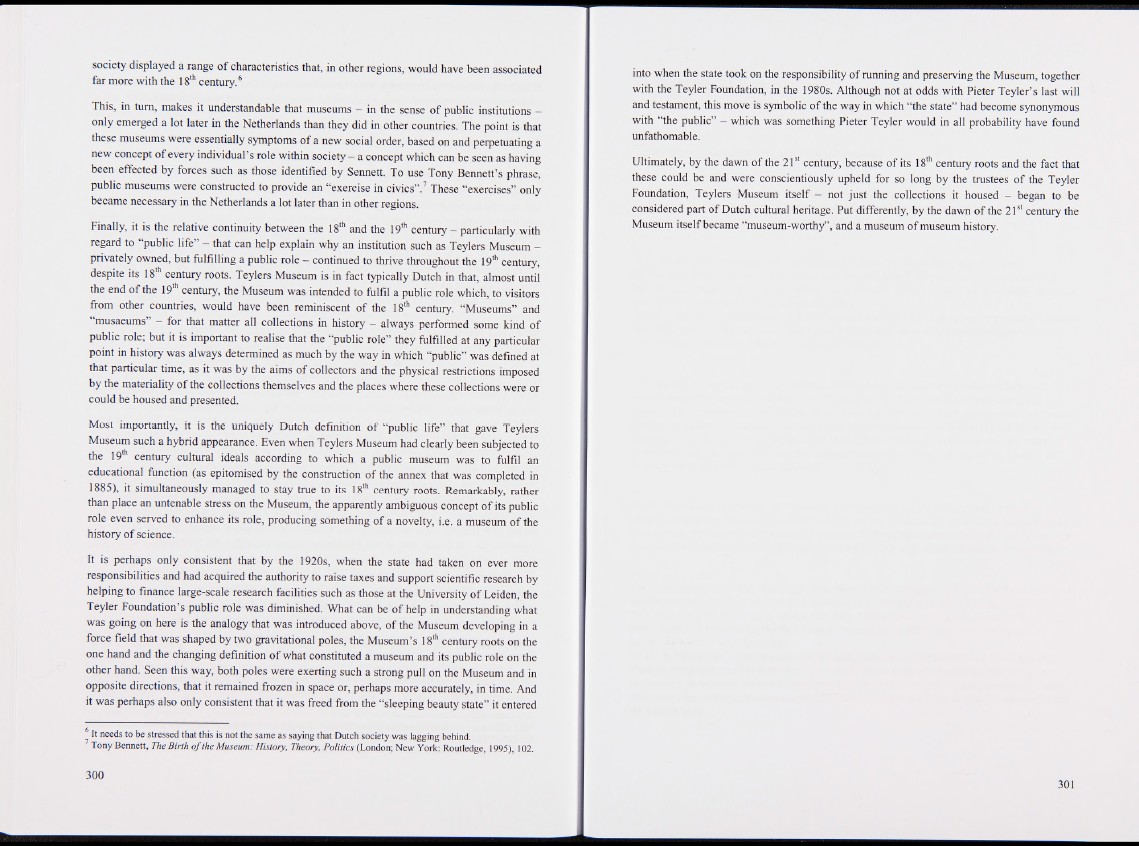
society displayed a range of characteristics that, in other regions, would have been associated
far more with the 18th century.6
This, in turn, makes it understandable that museums - in the sense of public institutions -
only emerged a lot later in the Netherlands than they did in other countries. The point is that
these museums were essentially symptoms of a new social order, based on and perpetuating a
new concept of every individual’s role within society — a concept which can be seen as having
been effected by forces such as those identified by Sennett. To use Tony Bennett’s phrase,
public museums were constructed to provide an “exercise in civics”.7 These “exercises” only
became necessary in the Netherlands a lot later than in other regions.
Finally, it is the relative continuity between the 18th and the 19th century - particularly with
regard to public life — that can help explain why an institution such as Teylers Museum —
privately owned, but fulfilling a public role Bcontinued to thrive throughout the 19th century,
despite its 18th century roots. Teylers Museum is in fact typically Dutch in that, almost until
the end of the 19 century, the Museum was intended to fulfil a public role which, to visitors
from other countries, would have been reminiscent of the 18th century. “Museums” and
musaeums — for that matter all collections in historyB always performed some kind of
public role; but it is important to realise that the “public role” they fulfilled at any particular
point in history was always determined as much by the way in which “public” was defined at
that particular time, as it was by the aims of collectors and the physical restrictions imposed
by the materiality of the collections themselves and the places where these collections were or
could be housed and presented.
Most importantly, it is the uniquely Dutch definition of “public life” that gave Teylers
Museum such a hybrid appearance. Even when Teylers Museum had clearly been subjected to
the 19 century cultural ideals according to which a public museum was to fulfil an
educational function (as epitomised by the construction of the annex that was completed in
1885), it simultaneously managed to stay true to its 18th century roots. Remarkably, rather
than place an untenable stress on the Museum, the apparently ambiguous concept of its public
role even served to enhance its role, producing something of a novelty, i.e. a museum of the
history of science.
It is perhaps only consistent that by the 1920s, when the state had taken on ever more
responsibilities and had acquired the authority to raise taxes and support scientific research by
helping to finance large-scale research facilities such as those at the University of Leiden, the
Teyler Foundation s public role was diminished. What can be of help in understanding what
was going on here is the analogy that was introduced above, of the Museum developing in a
force field that was shaped by two gravitational poles, the Museum’s 18t6 century roots on the
one hand and the changing definition of what constituted a museum and its public role on the
other hand. Seen this way, both poles were exerting such a strong pull on the Museum and in
opposite directions, that it remained frozen in space or, perhaps more accurately, in time. And
it was perhaps also only consistent that it was freed from the “sleeping beauty state” it entered
6 It needs to be stressed that this is not the same as saying that Dutch society was lagging behind.
Tony Bennett, The Birth o f the Museum: History, Theory, Politics (London; New York: Routledge, 1995), 102.
into when the state took on the responsibility of running and preserving the Museum, together
with the Teyler Foundation, in the 1980s. Although not at odds with Pieter Teyler’s last will
and testament, this move is symbolic of the way in which “the state” had become synonymous
with “the public*- which was something Pieter Teyler would in all probability have found
unfathomable.
Ultimately, by the dawn of the 21st century, because of its 18th century roots and the fact that
these could be and were conscientiously upheld for so long by the trustees of the Teyler
Foundation, Teylers Museum itself - not just the collections it housed - began to be
considered part of Dutch cultural heritage. Put differently, by the dawn of the 21st century the
Museum itself became “museum-worthy”, and a museum of museum history.